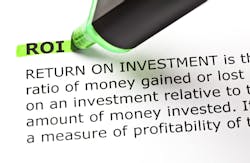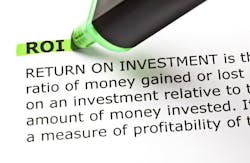Performing a Return on Investment (ROI) analysis is fundamental in business decisions. Unfortunately, the process is often too simplistic or misguided (as often practiced), thereby producing suboptimal outcomes.
We’ll explain various ROI methods in a bit (see Financial Analysis Methods in a Nutshell). But let’s first take a look at what may happen when using a method that depends upon knowing your cash flows; that is, how much cash is flowing in versus how much is flowing out. The method we’ll use is called Modified Internal Rate of Return (MIRR).
In this business, you can’t live without good test equipment. So electrical firms and maintenance organizations often buy new test equipment. Now, consider a weakness that can come into play when making assumptions about your cash flows.
Let’s say you’re thinking about a high-end infrared camera. So you plug in the cost of that and then run the numbers for a less expensive camera. Gee, the less expensive camera gives you a better MIRR. But you have to look at the “why?” behind this outcome to avoid making a poor decision.
You might assume that your people will “pick up” basic thermography skills on their own from the manual and maybe a one-hour webinar. What you’ve left on the table are all the high-profit things a Level I thermographer can do with that higher-end camera. So you run the MIRR again, this time accounting for the cost of training and labor (increased cash outflow) and the additional revenue (increased cash inflow). Hmm. Now that higher-end camera is a “must have” you wish you’d had already.
You could do a more complex analysis, this time including Level II certification to commence in year 2. Now the cash inflows for subsequent years will be larger just from the thermography work. But many of these thermography services can get your foot in the door of a client with whom you could potentially do major business. So when you factor that in, guess what? That higher-end camera has a far higher MIRR than the less expensive one.
When determining ROI, always ask those “why” questions about the numbers you get. When it comes to things like test equipment, a little more investment can produce a much greater ROI.
Financial Analysis Methods in a Nutshell
If you’re not already using a cash flow-based method for calculating ROI, what you’ll read next may change your profit picture for the better. Maybe even considerably better.
A commonly used ROI calculation is one called Payback. You determine how long it takes to recoup your investment. While at first glance this sounds useful, it actually can be very misleading and even costly. It is more likely to lead to poor business decisions than to sound business decisions.
Payback doesn’t take into account cash flows, the cost of capital, or the time value of money. For these reasons, it doesn’t let you accurately compare one spending decision against another. You can have opportunity costs if you choose the wrong one. For example, Payback can lead you to choose a $50 profit decision over a $500 profit decision.
More sophisticated ROI calculation methods are available. The next step up from Payback is the simple Percent Return. For example, you spend $1,000 and get $1,100 back. That’s a 10% return. Not bad. If you had to choose between a 10% return and a 5% return, is it obvious which one you should choose?
Not really. If you invested $10,000 and made 5%, you’d get back $500. That’s five times the money you made on that 10% investment. Obviously, you’d prefer to get $500 rather than $100.
Another flaw in Percent Return is it doesn’t account for the cost of borrowing that $10,000. If that cost is 8% but you don’t have to borrow to make the $1,000 investment now you have a different scenario.
As any business executive knows, cash flow is critical. Running out of cash is the number one cause of business failure. So when and how will you get your money back? While Payback may appear to answer this, it does not. Will the money come back in equal amounts each month, mostly upfront, mostly toward the end, or all at the end? And how will you manage your cash needs in the meantime?
Consider these questions, which neither Payback nor Percent Return can help you answer:
• How do you balance the finance payments going out against the cash coming in?
• Will purchasing this test equipment (or sending people to this training course) mean you must defer some other test equipment purchase? Or not take on X project? Or will it enable you to do cash cow work to alleviate your cash flow pressure?
•Will cash flow constraints of this project mean you canât take on other new ones for the next six months? Will it interfere only for the first three months or not at all?
So neither Percent Return nor Payback will give you a sound basis for comparing investments or making a business decision. This is why financial types seldom, if ever, consider either one. These methods are distracting, rather than useful, because they are incomplete. They just do not give enough information on which to base a sound business decision. Thatâs why people with a finance background let these ROI methods RIP.
The ROI methods that give you a basis for a sound business decision require you to determine the incoming and outgoing cash flows, and the cost of capital. An Internal Rate of Return (IRR) calculation is such a method. An improved version of this is the Modified Internal Rate of Return (MIRR). Any modern spreadsheet program includes a means of performing these calculations.
When you calculate IRR (or MIRR), the result is expressed as a percentage. But donât confuse this with the much simpler (and less helpful) calculation of Percent Return. Because the IRR method (modified or not) accounts for your cash flows and your cost of investment capital, you get a number that takes into account the real financial impact of the decision.
Of course, you also must take the time to determine how the cash will (or should) flow and know how much it will cost you to finance the outgoing flows. But the effort is worth it for reasons discussed above.
So now you know which type of financial calculation to use. But should this be the basis for your decision? The answer is the ROI calculation should be a major input into the decision, not the sole basis. For example, is this proposed project too risky? Does it fall within your expertise?
Donât always go for the highest ROI. You must balance ROI against other factors, such as risk of failure (or callbacks), available resources, required resources, and impact on other projects.
About the Author

Mark Lamendola
Mark is an expert in maintenance management, having racked up an impressive track record during his time working in the field. He also has extensive knowledge of, and practical expertise with, the National Electrical Code (NEC). Through his consulting business, he provides articles and training materials on electrical topics, specializing in making difficult subjects easy to understand and focusing on the practical aspects of electrical work.
Prior to starting his own business, Mark served as the Technical Editor on EC&M for six years, worked three years in nuclear maintenance, six years as a contract project engineer/project manager, three years as a systems engineer, and three years in plant maintenance management.
Mark earned an AAS degree from Rock Valley College, a BSEET from Columbia Pacific University, and an MBA from Lake Erie College. He’s also completed several related certifications over the years and even was formerly licensed as a Master Electrician. He is a Senior Member of the IEEE and past Chairman of the Kansas City Chapters of both the IEEE and the IEEE Computer Society. Mark also served as the program director for, a board member of, and webmaster of, the Midwest Chapter of the 7x24 Exchange. He has also held memberships with the following organizations: NETA, NFPA, International Association of Webmasters, and Institute of Certified Professional Managers.

